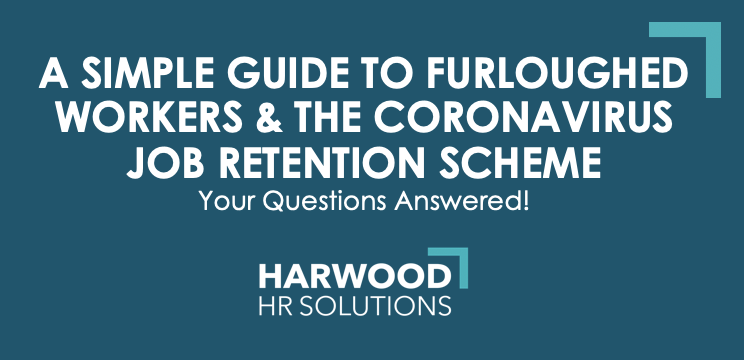Following our webinar “A Simple Guide to Furloughed Workers and The Coronavirus Job Retention Scheme” we had lots of questions through and so have recorded these and our responses to share with you all.
I hope that you find them helpful!
If you need any support with this, redundancies or how to manage employees who are remote working / furloughed, please get in touch.
“If I Furlough employees and cannot take them back when the scheme finishes, as I need to build up my business again, what should I do? I have read I may have to pay the 80% back to the government if I make them redundant -is this correct, what should I do?”
No this is not true. An employer would not be required to repay the grant it has received for the employee’s wage while they were furloughed.
HMRC guidance on the scheme states that, when the scheme ends, employers will have to decide whether employees can return to work, or if redundancies may be necessary.
The employer would have to comply with the normal procedural requirements in relation to notice and consultation before making employees redundant.
While it confirms the position regarding redundancies when the Coronavirus Job Retention Scheme closes, the HMRC guidance does not state that a furloughed employee cannot be made redundant while the scheme is still open. Therefore, it appears that an employer could terminate an employee’s contract for redundancy while they are furloughed, provided that it complies with the relevant procedural requirements. The position may be clarified in further government guidance on the scheme.
“How does the furlough process work for those of us who are employed by our own companies as Directors where we take a modest “wage” and directors fees and pay full PAYE. There seems to be a perspective that we are “self-employed”
If you are a director paid through PAYE you can be furloughed in the same way an employee can and claim through the scheme for the salary elements that are paid through PAYE. Directors can still perform statutory duties, for example, accounts, payroll etc; but cannot perform any revenue generating work. Self-employed individuals are not paid through PAYE, do not pay tax in the same way an employee does and complete a self-assessment return at the end of the year. So, if you are a director of a limited company with limited liability, you would follow the furlough process as opposed to the Self-employed income support scheme. In any case, the HMRC will make an assessment based on previous tax return and company status and ask you to apply online for this scheme if applicable to you.
“Our employees are on zero hours contract (we are a hotel), it’s going to be difficult to furlough employees as we think it will take up to twelve months to be back to where we were. Also, one employee only started mid-February, will he be eligible having worked five weeks”
Given that it is really difficult to predict the future at this stage, the best option really is to furlough employees if they are not working and then review this again at the end of the 3 months. As we have discussed today, the purpose of the coronavirus job retention scheme is to prevent redundancies and so it may be a little too soon to act now. Given that they are on zero-hour contracts, it is a good idea to understand if they are workers or employees. If they are workers, you can simply look to give notice to end the contract, however, if they are employees, there is a process to following including providing notice.
In regards to the employee who started mid Feb – if he was on payroll on or before 19th March, he can be placed on furlough.
“We are a contract flooring company and our labour on site is a mix of PAYE and subcontractors. We are furloughing our employees on PAYE. Are we still at liberty to continue to use sub-contractor labour on the sites that currently remain open, while our own PAYE employees are furloughed?”
I think here you need to consider what you would do in a normal redundancy situation. Ordinarily, the first thing a business should do in this instance, would be to look at releasing contractors first; except in the case of course, where there is a particular expertise that is required from them. You should then work through to assess what other roles could be removed. There could be the argument that if you can’t afford to keep the employees working, how can you afford to pay the contractors? So, in short, no there is no liability to keep them. Familiarise yourself with their contract, however, if they are true contractors, you should be releasing them before employees.
Can an employer rotate which employees are furloughed during the coronavirus crisis?
Guidance published by HMRC states that the minimum period an employee can be furloughed for is three weeks. Therefore, it appears that an employer can rotate employees between periods of work and periods of furlough, as long as they are furloughed for at least three weeks at a time. An employer may choose to do this to avoid disputes over which staff are chosen to be furloughed, where it needs some staff to continue working during the crisis.
Can an employer withdraw notice of redundancy that was given before the announcement of the Coronavirus Job Retention Scheme?
Some employers facing immediate financial difficulty because of the coronavirus crisis will have given notice of redundancy to employees before the scheme was announced. HMRC guidance states that these employers can ask the employees to agree to the withdrawal of the notice, and to agree to a period of furlough instead.
Once notice of redundancy has been issued to an employee, it is legally binding and cannot be unilaterally withdrawn by the employer, even if the employee is still working out their notice period. Therefore, the employer must obtain the express consent of the employee. In the circumstances, it is likely that employees will agree to keeping their jobs, while staying at home on reduced pay, as an alternative to redundancy. The employer can agree to top up the wages of the employee, so they are paid in full, but it is not obliged to do so.
Can employers bring back employees who were made redundant before the Coronavirus Job Retention Scheme was announced, and make a claim for them under the scheme?
HMRC guidance on the scheme states that employees that were employed as of 28 February 2020 and on payroll (i.e. notified to HMRC on an RTI submission on or before 28 February) and were made redundant or stopped working for you after that, and prior to 19 March 2020, can also qualify for the scheme if you re-employ them and put them on furlough.
The employer cannot make a claim under the scheme in relation to employees who were not on the payroll on 28 February 2020. Employees who had already been made redundant by that date are not covered.
We run community transport and have workers over 70 who have had to self-solate. Are they on SSP for 12 weeks or can we furlough them?
Can you top up 80% for furloughed workers to full pay?
Employees who are at very high risk of severe illness from coronavirus and are therefore advised to shield themselves for at least 12 weeks, can be furloughed. Those aged 70 and over are classed as high risk or ‘vulnerable people’ according to the government. IF they are unable to work from home and their role would be furloughed if they were not self-isolating, then you can furlough them. If their role is required and they have not received a letter from the NHS categorising them as high risk, but are self-isolating it would be unpaid.
Employees who are on sick leave or who are self-isolating can be furloughed only after the period of sickness or self-isolation has ended. During this time, they will be entitled to statutory sick pay.
Yes, you employers can top up to full pay if they wish, but are not obliged to do so.
We have an employee who started on the 24th Feb. We pay our staff 2 weeks in hand therefore the new employee was not on our Feb payroll. Do you know if we could claim Furlough for this person?
The scheme now states that you can claim for employees that were employed as of 19 March 2020 and were on your PAYE payroll on or before that date; this means that you will have made an RTI submission notifying HMRC of payment of that employee on or before 19 March 2020 and so will depend if they meet this requirement?
If they are not eligible and you have no work for this person, there is still the option to consider lay-off, but this would under the usual lay-off terms, i.e. no pay other than the statutory guarantee payments.
Hi, we are a 2 director company (me and my partner). We have a number of contracts paused so can 1 of the directors be furloughed? We have been trading for a year but I have only been paying myself for the past 3 months. Do you know how the amount you can claim will be calculated?
Yes, you do not have to furlough all employees where some are required to continue working and so this will be the same for Directors. You can claim for the salary element that has been paid to you through PAYE and so 80% of your normal wages up to £2,500. The grant is for 80% of the employee’s gross pay. The guidance states that “the employee’s wage will be subject to usual income tax and other deductions”.
Member of staff is on maternity. Requested return early inc reduced hour’s notice received but not accepted yet as we closed. can I delay the return or can I furlough on return?
Ensure that the member of staff isn’t returning too early under health and safety law (2 weeks Maternity Leave (4 weeks if you work in a factory or workshop) immediately following the birth of your baby).
If that is covered then you need to consider her return request (including reduced hours) following the flexible working process. If you can accommodate her flexible working request then you can agree to it however, you must inform her that she is required to be placed on furlough. You will reduce her hours and pay accordingly and claim back 80% of that.
You will need to write to her to confirm that you have agreed to her flexible working request (with a timescale to be reviewed if this is not a perm change) and also provide her with a Furlough Agreement to sign.
If our business has not been affected by coronavirus as a whole but specific departments have been, can we furlough the staff who fall in to the departments that have been? Can you just confirm that you said shielded employees should be sent home on full pay if the business is trading normally?
If whole departments have no work as a result of the current COVID-19 crisis, then you can furlough them.
Correct, if you have employees who need to shield they should be at home on full pay. If their role would be furloughed should they not already be shielding, then you can furlough.
I’m on Furlough leave, will my employer allowed to ask me to work during this time or not?
No work can be carried out while placed on furlough. Should the employer wish you to come back to work then can end furlough and bring you back in. The minimum period you can furlough for is 3 weeks.
Roll over hol. is that public or private sector?
Both for private and public sector. The government has made an adjustment to the working time directive to allow employees who have not been able to take leave due to COVID-19 to carry this over. For more info:
https://www.gov.uk/government/news/rules-on-carrying-over-annual-leave-to-be-relaxed-to-support-key-industries-during-covid-19
Hi, can you clarify the holiday situation during the furlough period? I understood that you could reduce the holiday ‘entitlement’ pro-rata for the time an employee is furloughed i.e. if an employee has a 28-day holiday entitlement, if furloughed for 12 weeks, their remaining holiday entitlement, assuming no days taken before the furlough period, would be reduced by 6.5 days
Employees will continue to accrue statutory annual leave while furloughed. Entitlement cannot be reduced.
With offices closed how do you recommend the consultation process?
In these circumstances, you can arrange to hold consultation via phone, whether it be group or individual calls. Where possible try to ensure that staff get the same info at the same time if it is affecting a number of people and so would suggest a conference call / skype / zoom session. Keep notes and a log for your records.
Is the £2,500 per employee net pay or gross pay? i.e. before or after deductions for income tax / NI
The grant is for 80% of the employee’s gross pay (up to £2,500). The guidance states that “the employee’s wage will be subject to usual income tax and other deductions”.
Thanks, we are thinking we’d like to enforce annual leave to both FT and zero hours employees for those that have furloughed, up to 80% of accrued entitlement to ensure that it is recoverable under the scheme…any thoughts?
Unfortunately, holiday pay is not recoverable. If you wished to request employees take annual leave, you would need to bring them off furlough for this period of time, pay full pay and then place back on furlough. If you wanted to do this, you must tell staff at least twice as many days before as the amount of days you want people to take. For example, if you want them to use 5 days, you should tell them at least 10 days before.
Can they then go back on furlough a second time?
Yes, they can be furloughed effectively more than once. As above, Guidance published by HMRC states that the minimum period an employee can be furloughed for is three weeks. Therefore, it appears that an employer can rotate employees between periods of work and periods of furlough, as long as they are furloughed for at least three weeks at a time. An employer may choose to do this to avoid disputes over which staff are chosen to be furloughed, where it needs some staff to continue working during the crisis.
Are apprentices eligible?
Yes, so long as they are paid through PAYE and were on payroll on 28th February.
What if someone has not been employed for 12 months on irregular hours?
Assuming this question is in relation to calculations of monthly wages;
If the employee has not worked for 12 months before the claim, the calculation should be based on their average monthly earnings since they started work.
If the employee started in February 2020, the guidance says the employer should “use a pro-rata for their earnings so far”, to calculate what they would earn in a month.
An employee handed in their resignation before all of this. Leave date 20/07/20 (we’re a term time only preschool) What do we do here? We are not expecting to go back with children before September so cannot “retain” her? She has also got a job at a local supermarket while we are shut.
You are under no obligation to rescind his / her resignation (despite what Martin Lewis said). If they are currently working their notice and would normally be earning at this time then you will need to furlough them. If the governments job retention scheme ends and you are still closed then you may need to consider extending into statutory lay-off which is likely to be unpaid. (Clearly you will need to fully understand their contract beforehand)
With regard to HMRC portal and the question re the claim period end date – is that open ended given the government isn’t able to define lockdown will end.
At present the only confirmation is that “The Coronavirus Job Retention Scheme is a temporary scheme open to all UK employers for at least three months starting from 1 March 2020”






